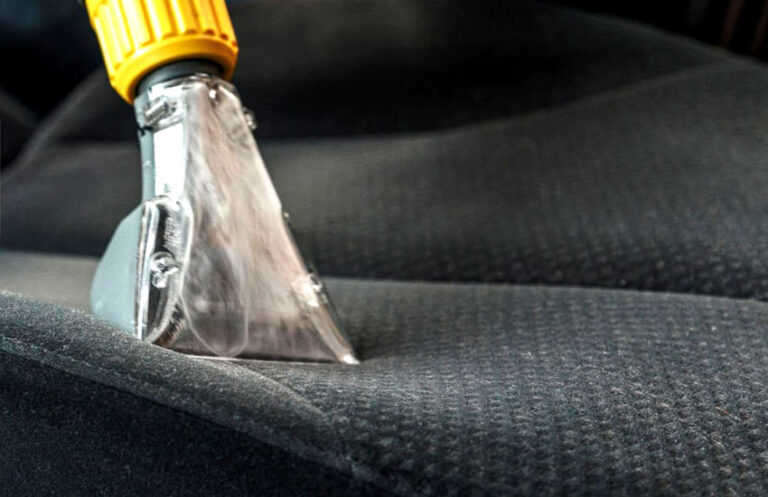As an Amazon Associate, I earn from qualifying purchases at no extra cost to you.
How to Clean Yellow Headlights at Home: A Step-by-Step Guide
Have you noticed your headlights turning yellow and cloudy over time? It's something most car owners face at some point. While yellow headlights can affect your car's overall look and reduce visibility, the good news is you don't need to go to an expensive auto shop to fix them. In this article, I'll walk you through easy and cost-effective ways to restore your headlights right at home. Whether you’re a DIY enthusiast or just looking for a quick solution, this article will help you get your headlights looking brand new!
Understanding Why Headlights Turn Yellow
Before diving into the cleaning process, it's important to understand why headlights turn yellow in the first place. This will give you a better idea of what you're dealing with and why regular maintenance is essential.
The Role of UV Exposure in Headlight Discoloration
Headlights are often made of polycarbonate plastic, which is prone to discoloration due to exposure to ultraviolet (UV) rays from the sun. Over time, the plastic begins to oxidize and break down under UV rays. As a result, the protective coating on the headlights degrades, causing yellowing or cloudiness.
The harsh elements of nature—such as rain, dust, and road salts—also contribute to the degradation of the headlight surface. The more exposed the headlights are to these elements, the quicker they begin to show signs of aging, including yellowing.
The Impact of Yellow Headlights
Yellowed headlights can significantly reduce the efficiency of your car's lighting system. When headlights become cloudy or discolored, the light they emit is scattered, reducing the brightness and making it harder to see the road clearly, especially at night or in poor weather conditions.
In addition to safety concerns, yellow headlights can also lower the resale value of your vehicle. Clean, clear headlights are often seen as a sign of well-maintained care. So, restoring their original shine can improve both visibility and the aesthetics of your car.
What You'll Need to Clean Your Yellowed Headlights
To clean yellow headlights at home, you'll need some simple materials and tools. While there are many commercial products available for this task, you can often restore your headlights with items you already have in your home or garage.
Here's a list of what you might need:
- Toothpaste (preferably with baking soda)
- Baking soda
- Vinegar or lemon juice
- Microfiber cloth
- Masking tape
- Water
- A small bucket
- A soft brush (toothbrush or similar)
- Clear coat spray (optional)
Having these items ready will ensure that the process goes smoothly. Let's dive into the step-by-step guide on how to restore your yellow headlights!
DIY Methods for Cleaning Yellow Headlights
Now that you understand why your headlights turn yellow and what tools you need, it's time to get into the cleaning process. There are several effective DIY methods you can use to restore your headlights. Here, we'll cover the most common and accessible methods: using toothpaste, vinegar, and baking soda.
Method 1: Toothpaste Treatment
One of the most popular DIY methods for cleaning yellow headlights is using toothpaste. It may sound surprising, but toothpaste contains mild abrasives that can help scrub away the oxidation and yellowing from the plastic surface.
Step-by-Step Guide to Using Toothpaste
- Preparation: Start by cleaning the headlights with soap and water to remove any surface dirt and grime. Dry them off with a clean cloth.
- Apply Masking Tape: Use masking tape to protect the areas around the headlights. You don't want to accidentally scratch your car's paint during the cleaning process.
- Apply Toothpaste: Squeeze a generous amount of toothpaste onto the headlight lens. You can use a soft-bristled brush or your fingers to spread the toothpaste over the entire surface of the lens.
- Scrub the Headlights: Use circular motions to scrub the toothpaste into the plastic. Apply moderate pressure, but avoid pushing too hard, as it can cause scratches.
- Let it Sit: Allow the toothpaste to sit on the headlights for about 5-10 minutes. This gives the abrasives time to break down the oxidation.
- Rinse and Wipe: After the waiting period, rinse the headlights with water. Use a microfiber cloth to wipe away the toothpaste. You should notice a significant improvement in the clarity of the lens.
- Repeat if Necessary: If the headlights are still yellowed, repeat the process once or twice until you achieve the desired clarity.
Why Toothpaste Works
Toothpaste works well because it contains mild abrasives, such as baking soda or silica, which help polish the plastic. These abrasives can remove the thin layer of oxidation without damaging the headlight. Additionally, toothpaste often contains a small amount of whitening agents that can further improve the appearance.
Method 2: Baking Soda and Vinegar Solution
Another effective method for cleaning yellowed headlights involves using a mixture of baking soda and vinegar. This combination creates a mildly abrasive paste that, when scrubbed onto the headlights, can break down oxidation and grime.
Step-by-Step Guide to Baking Soda and Vinegar Treatment
- Preparation: Just like the previous method, start by cleaning the headlights with water and soap. Dry them completely.
- Create the Paste: In a small bowl, mix two tablespoons of baking soda with enough vinegar to form a paste. Stir the mixture until smooth and thick.
- Apply the Paste: Use a soft brush or cloth to apply the paste to the headlights. Cover the entire lens evenly, focusing on areas with visible yellowing.
- Scrub Gently: Use a soft cloth or brush to scrub the paste into the surface. Again, use circular motions, applying moderate pressure. Be sure to cover every part of the headlight.
- Let it Sit: Leave the paste on the headlights for 5-10 minutes to allow the baking soda and vinegar to break down the oxidation.
- Rinse and Dry: Rinse the headlights with water and wipe away the paste with a clean microfiber cloth. You should notice a much clearer lens after this step.
- Repeat if Needed: For stubborn yellowing, repeat the process a few times.
Why Baking Soda and Vinegar Work
Baking soda is slightly abrasive, which helps scrub away the oxidation on the headlight surface. Vinegar, being acidic, helps dissolve grime and buildup that contributes to yellowing. When combined, these ingredients create a powerful yet safe solution to restore your headlights' clarity.
Method 3: Lemon Juice and Baking Soda
If you want a fresh, natural alternative, lemon juice can also do wonders for yellowed headlights. Lemon juice's acidity helps break down oxidation, while baking soda adds a gentle abrasive element to scrub away stains.
Step-by-Step Guide to Using Lemon Juice and Baking Soda
- Clean the Headlights: As with the other methods, start by cleaning the headlights with soap and water to remove any dirt and grime. Dry them thoroughly.
- Mix the Paste: In a bowl, combine the juice of half a lemon with two tablespoons of baking soda. Stir the mixture until it forms a paste.
- Apply the Paste: Use a soft brush or cloth to spread the paste over the headlight lens. Be sure to cover the entire surface evenly.
- Scrub and Let Sit: Use circular motions to scrub the paste into the plastic. Leave the paste on for 5-10 minutes to let the ingredients work their magic.
- Rinse and Dry: After waiting, rinse the headlights with water and wipe away the paste with a microfiber cloth.
- Repeat if Necessary: If the headlights are still yellow, you can repeat the process once or twice for better results.
Why Lemon Juice and Baking Soda Work
Lemon juice is a natural acid that can break down the yellowing caused by oxidation, while baking soda provides mild abrasiveness to scrub away the buildup. Together, they create a gentle yet effective solution for cleaning yellow headlights.
Preventing Future Yellowing of Your Headlights
After cleaning your headlights, you might wonder how to prevent them from yellowing again in the future. Thankfully, there are several ways to protect your headlights and keep them looking clear for a longer time.
Step 1: Apply a Clear Coat
After cleaning and restoring your headlights, consider applying a clear coat to protect them from future yellowing. Clear coat sprays can be found at most auto parts stores and are easy to apply.
- Spray the clear coat: Once your headlights are clean and dry, spray a thin layer of clear coat over the surface. This will add a protective layer to the plastic, shielding it from UV rays and environmental elements.
- Let it dry: Allow the clear coat to dry completely before driving your car.
Step 2: Regular Cleaning and Maintenance
Regularly clean your headlights with soap and water to remove dirt and grime. Additionally, you can apply the methods described above every few months to maintain clarity. By staying on top of maintenance, you can prevent heavy buildup and yellowing.
Step 3: Park in the Shade
Whenever possible, try to park your car in the shade to minimize UV exposure. While it's not always feasible, parking under a carport or using a windshield cover can help reduce the sun’s impact on your headlights.
Step 4: Use Headlight Covers
Headlight covers are another preventative measure you can consider. These are protective films or covers that adhere to your headlights to shield them from the elements. While they might not be as effective as cleaning and clear coating, they can provide an extra layer of protection.
I hope this guide helps you restore the clarity of your headlights without having to spend a fortune at a repair shop! By using simple household items and following a few easy steps, you can make your headlights shine bright once again. Remember, regular maintenance is key to keeping them clear and functional, so don’t forget to check them periodically.
Frequently Asked Questions (FAQs)
Is it safe to clean yellow headlights with toothpaste?
Yes, cleaning yellow headlights with toothpaste is safe and effective. Toothpaste contains mild abrasives that help scrub away oxidation without damaging the plastic. Just be sure to use a non-gel toothpaste and follow the proper cleaning steps.
Can vinegar and baking soda damage my headlights?
No, vinegar and baking soda are safe to use on headlights when mixed properly. Both ingredients are mild and non-abrasive, so they won't damage the plastic. However, be sure to rinse the headlights thoroughly after cleaning.
Do I need to apply a clear coat after cleaning my headlights?
While applying a clear coat is not mandatory, it is highly recommended. A clear coat provides an added layer of protection against UV rays and environmental damage, helping to keep your headlights from yellowing again quickly.
Is there a commercial product that works better than DIY methods?
There are several commercial headlight restoration kits available that might offer quicker results or more advanced protection. However, DIY methods using household items like toothpaste, vinegar, and baking soda are often just as effective and much more affordable.
Is it possible to permanently remove the yellowing from headlights?
While you can restore clarity to your headlights using DIY methods, the yellowing may return over time, especially with prolonged exposure to the sun. Regular cleaning and applying a protective clear coat can extend the life of your headlight restoration.
Can I clean the inside of my headlights?
It's generally not necessary to clean the inside of the headlights unless there's noticeable moisture or fogging inside. If this happens, it's best to consult a professional to ensure there's no issue with the headlight seal.
Do I need any special equipment to restore my headlights?
No special equipment is required to clean your headlights. Simple tools like a microfiber cloth, soft-bristled brush, and common household items such as toothpaste, vinegar, or baking soda are all you need for a DIY restoration.
Is it possible to clean heavily yellowed headlights at home?
Yes, even heavily yellowed headlights can be cleaned at home with patience. You may need to repeat the cleaning process a few times to get the best results. If the yellowing is extremely severe, a professional restoration might be required.




